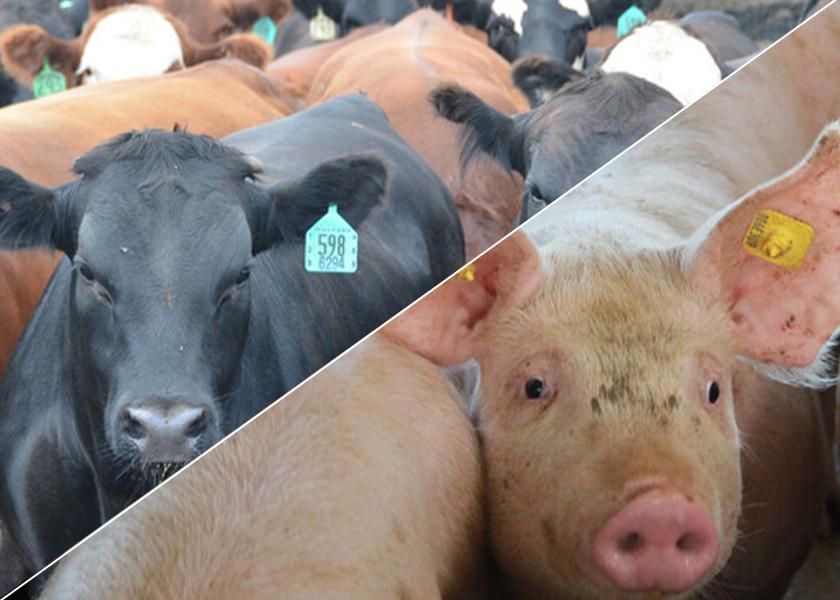Livestock Analysis | September 23, 2022

Price action: October lean hog futures fell $1.50 to $92.625, down $4.275 for the week. Most-active December futures fell $2.875 to $82.80.
5-day outlook: Livestock futures tumbled with other commodity markets today as the Federal Reserve’s recent interest rate hike fueled increasing concern over a global recession that could curtail meat demand. Prospects for softer cash prices also weighed on hog futures. The CME lean hog index rose 5 cents to $98.01 (as of Sept. 21), but Monday’s quote is expected to decline 42 cents. Weaker cash, combined with eroding technicals, may pressure hog futures early next week. Traders await USDA’s quarterly Hogs and Pigs Report Sept. 29.
30-day outlook: The Hogs and Pigs report will set the market’s tone for October, as the numbers will offer insight into animal supplies later this year and in 2023. We expect hog numbers and slaughter to run 1% to 2% under year-ago levels in the short-run, but the supply outlook beyond that point is open to question. We believe seasonal strength will persist through late September and early October, with cash hog and pork prices likely working sideways to higher. Futures clearly imply the price outlook will be weaker, but we are still inclined to expect retail pork demand to hold up better than many expect in any recession.
90-day outlook: Our outlook for hog supplies during the fourth quarter at 1% to 2% under year-ago levels, contrasts with USDA, which has estimated numbers to match or slightly exceed late-2021 levels. Any shift in supplies will exert considerable influence over futures, and there is also a great deal of uncertainty over consumer demand. We suspect beef and pork demand under recessionary conditions will not suffer that badly, thinking consumers will cut back on restaurant visits and buy more meat for eating at home instead. But there is clearly a great deal of pessimism on this point built into hog futures.
What to do: Be prepared to extend feed coverage when market bottoms are in place.
Hedgers: Carry all risk in the cash market for now.
Feed needs: You are hand-to-mouth on corn-for-feed and soybean meal needs.
Price action: December live cattle fell 80 cents to $148.55, a seven-week low and down $2.425 for the week. November feeder cattle futures rose 20 cents to $178.25, down $4.50 for the week.
5-day outlook: Cattle futures faded sharply late this week as heightened geopolitical and recession worries sent financial and commodity markets reeling. Consumer confidence may be shaken, which bodes poorly for beef demand. Today’s technically bearish weekly low closes also suggest follow-through chart-based selling pressure early next week. USDA’s Cattle on Feed Report today showed the Sept. 1 feedlot inventory up 0.4% over the year-earlier level, with placements up a stronger than expected 0.4% and marketings 6.4% above year-ago levels. The report is generally neutral and likely will have limited impact on prices Monday, though there could be some bull spreading in live cattle with both marketings and placements near the top end of the pre-report range of estimates.
30-day outlook: Cash cattle prices firmed this week, giving producers some hope the market has bottomed and will continue to trend up in coming weeks. USDA-reported live steers averaged $144.90 through Thursday morning, up from last week's $143.19 average. Also, the recent rise in cattle slaughter, which has averaged 2.8% above year-ago levels the past four weeks, suggests the supply of market-ready cattle in feedlots is tightening. Steer weights have also moved below year-ago levels, confirming the tightening supply.
90-day outlook: The health of the U.S. economy the rest of this year is in question, with many anticipating recession for U.S. and possibly other countries. That’s considered bearish for domestic and foreign demand for U.S. beef. However, a recession may not damage demand for beef as much as some think, as consumers are likely to eat out less and instead dine at home more. Additionally, tight animal supplies likely will provide longer-term support for the market, as illustrated by February live cattle futures’ premium of over $8 to nearby October.
What to do: Be prepared to extend feed coverage when market bottoms are in place.
Hedgers: Carry all risk in the cash market for now.
Feed needs: You are hand-to-mouth on corn-for-feed and soybean meal needs.






